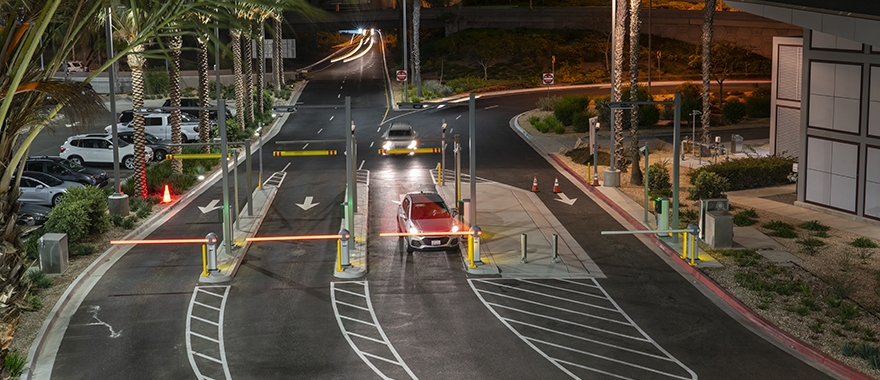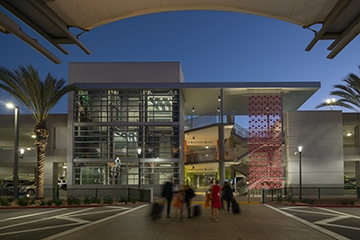The Technology Challenge: How Design-Build Delivered a Seamless Airport Parking Experience

Whether we travel for work or travel for pleasure, we often do it by plane. However, before we can take to the sky to get to our destination, we have to take an important first step: getting to the airport. The last time you flew, how did you arrive at the airport? Do you catch a ride with a friend or a TNC? Did you park? If so, was your experience a positive one?
The San Diego International Airport wanted the answer to that last question to be “yes.” Ensuring a premier passenger experience was a crucial part of the plan when the Airport required additional structured parking to meet demand. They did not want simply a parking garage to store cars in; they envisioned a Parking Plaza that would be quick and easy to use. Key to realizing that vision? Technology.
Delivering on that vision came with a number of challenges. In order to conquer them, the design-build team of Swinerton, Watry Design and Gensler got to work addressing them on day one. This collaborative effort resulted in a parking experience that is swift, efficient and designed around the user.

Collaborative, Coordinated Design Effort
The Terminal 2 Parking Plaza features parking guidance systems (PGS), adaptable parking access and revenue control systems (PARCS) and integrated mobile apps. These high-level technology systems require a great deal of infrastructure. Additionally, the extensive conduits and piping required to facilitate the various technology systems have the potential to be very visible and aesthetically unappealing.
In order to conceal this technological infrastructure in a facility the size of the Parking Plaza – which provides 2,900 spaces within a 330,000 square foot footprint – miles of conduits needed to be embedded into the concrete slab alongside post-tensioning and rebar. With such little room for error, it was vital that the design-build team partner with a technology consultant before even undertaking the RFP pursuit.
“We began planning for and coordinating the technology three years before we ever put a shovel in the ground,” says Jeff Goodermote, Director of Parking Structures with Swinerton, the project’s Design Builder. “Understanding how important it was to the Airport, we engaged a technology consultant on day one and gave them a voice throughout the problem solving process.”
That process included a four-month coordination effort to identify how the infrastructure for parking guidance, revenue and access control, lighting, Wi-Fi, etc. could be integrated into a 5-inch thick concrete slab.
Another challenge the design-build team tackled early was determining which vendor to utilize for each system – a decision that usually takes place later in the design process. However, different vendors require different provisions for a given system, such as a physical box for every connection, versus end-of-aisle points of connection. Given the the size and scope of the Parking Plaza, designing the infrastructure for even one set of provisions was a challenge in and of itself. Designing for more than one wasn’t feasible.
“You could have up to 60 conduits in the deck coming into one room,” Goodermote adds. “That’s five feet of just conduits. Managing that requires additional IT rooms, which results in additional loss of parking. There are lots of decisions in play, so technology was a critical piece of the design and construction of this project that could not be brought in later – it had to be part of the initial process.”

Creating the Right First Impression
Recognizing how important it was for the Airport to create a positive relationship with their passengers in order to compete with other options, like ride sharing, the design-build team emphasized a combination of easy-to-use, flexible, time saving systems. “Each component, from parking access to parking guidance, integrates seamlessly to set the tone for the entire experience, starting with the first interaction,” says Michael Pendergrass, Associate Principal with Watry Design.
For some users, that interaction begins before even leaving home with an online reservation system that allows travelers to pay for parking in advance of their arrival. The user-friendly interface was carefully designed to be simple and flexible. The system is capable of accepting discount codes and coupons, and frequent fliers can benefit from a loyalty program. To further strengthen customer engagement, the entire process is managed directly by the Airport.
“There is no third party branding, because the Airport maintains ownership of that customer journey from start to finish,” says Chris McKenty, Regional Advisor & Senior Key Account Manager for SKIDATA. “They wanted to be responsible for that experience.” The advance reservation system will also help the Airport manage their parking inventory more efficiently than just relying on historical data and allows for VIP reserved parking areas in the future.
For those whose first experience with the Parking Plaza happens upon reaching the Airport, technology still shoulders the responsibility of that critical first impression. Therefore, entry and exit were designed to be as frictionless as possible.
The parking control and access gates are equipped with LPR technology that scans both front and rear license plates. This improves efficiency by giving the cameras two chances to get a good plate read. Travelers who have prepaid for parking only need to scan a QR code to gain entry, though in the future the system will match a license plate to a prepaid reservation and open automatically. Staff and contractors can access the Plaza via Automatic Vehicle Identification (AVI) technology. The system is also designed for future integration with California’s FastTrack toll system, which will allow users to pay via their FastTrack accounts.
This flexibility makes for a smoother, faster entry and exit, which reduces stress and helps passengers get where they need to go as quickly and efficiently as possible.

Dynamic Technology
Once users gain access to the Parking Plaza, parking guidance technology takes over to help them find a space, reducing the need for searching and circling. The system selected by the Airport uses camera based sensors to detect whether or not a vehicle is occupying a parking stall, and conveys that information to display real time availability at key points throughout the structure. “Every decision point has a dynamic sign to help drivers determine whether they should go left, right or continue ahead,” says McKenty.
The first sign of this nature can be found before even entering the facility. It informs drivers how much parking is available on each level and where they can find accessible, electric vehicle and clean air vehicle spaces. “If more parking is available on the upper levels, speed ramps allow travelers to save time by bypassing the main level entirely,” says Pendergrass. Additional signage can be found on each level and in each aisle. Travelers are able to park quickly and head to their flights in the adjacent Terminal 2 without delay.
Above and beyond getting passengers parked, the parking guidance system was also carefully integrated into the functional design to improve safety. Cars are directed east to west through the Plaza, while pedestrians move south to north, in the direction of the terminal and away from vehicular traffic.
Upon returning to their vehicles, travelers who have not prepaid for parking can use pay-on-foot stations to expedite exit. The LPR cameras installed at the exit will match scanned plates with whatever credential previously used to pay for parking and open automatically, without the need to stop and scan a QR code. Those who still need to pay can also do so upon exit.
The extensive coordination that went into creating this experience is also evident in what you can’t see: there are no exposed conduits or cabling in the Plaza, ensuring that beyond its time saving benefits, the interior appears open, inviting and pleasant.
Through the collaborative efforts of the design-build team, the completed Parking Plaza delivers on the vision of a premier passenger experience by heavily leveraging parking technology.






